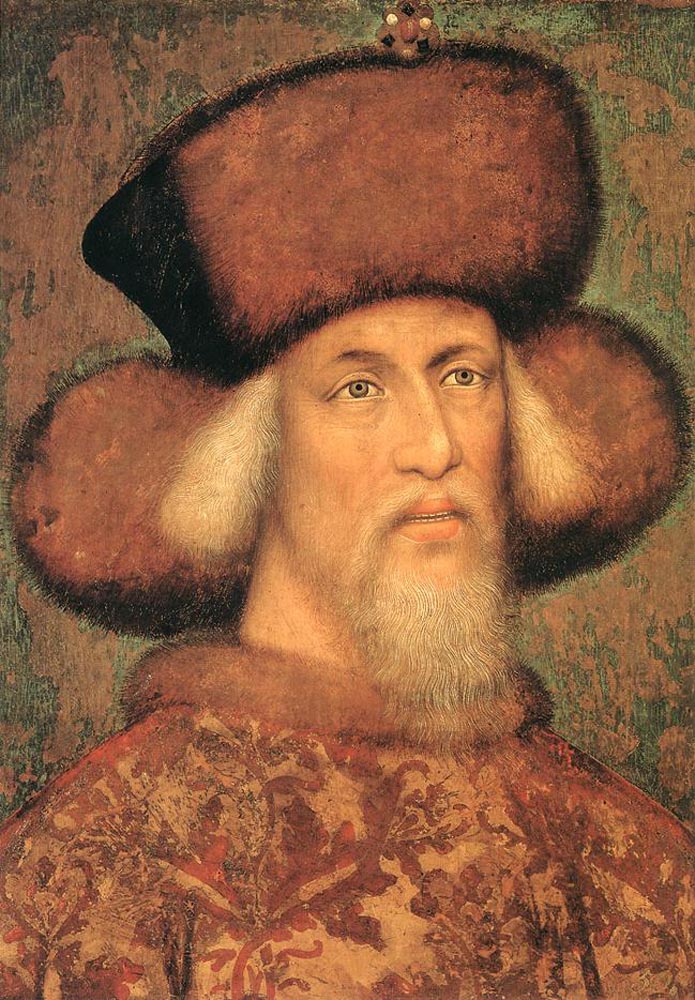
Sigismund, Holy Roman Emperor
Sigismund of Luxembourg[a] (15 February 1368 – 9 December 1437) was Holy Roman Emperor from 1433 until his death in 1437. He was elected King of Germany (King of the Romans) in 1410, and was also King of Bohemia from 1419, as well as prince-elector of Brandenburg (1378–1388 and 1411–1415). As the husband of Mary, Queen of Hungary, he was also King of Hungary and Croatia (jure uxoris) from 1387. He was the last male member of the House of Luxembourg.[1]
Sigismund
1433–1437
31 May 1433, Rome
1387–1437
31 March 1387, Székesfehérvár
1410–1437
8 November 1414, Aachen
1419–1437
27 July 1420, Prague
15 February 1368
Free Imperial City of Nuremberg, Holy Roman Empire
9 December 1437 (aged 69)
Znojmo, Kingdom of Bohemia
Sigismund was the son of Charles IV, Holy Roman Emperor and his fourth wife Elizabeth of Pomerania. He married Mary, Queen of Hungary in 1385 and was crowned King of Hungary soon after. He fought to restore and maintain authority to the throne. Mary died in 1395, leaving Sigismund the sole ruler of Hungary.
In 1396, Sigismund led the Crusade of Nicopolis, but was decisively defeated by the Ottoman Empire. Afterwards, he founded the Order of the Dragon to fight the Turks and secured the thrones of Croatia, Germany and Bohemia. Sigismund was one of the driving forces behind the Council of Constance (1414–1418) that ended the Papal Schism, but which also led to the Hussite Wars that dominated the later period of his life. In 1433, Sigismund was crowned Holy Roman Emperor and ruled until his death in 1437.
Historian Thomas Brady Jr. remarks that Sigismund "possessed a breadth of vision and a sense of grandeur unseen in a German monarch since the thirteenth century". He realized the need to carry out reforms of the empire and the Church at the same time. But external difficulties, self-inflicted mistakes and the extinction of the Luxembourg male line made this vision unfulfilled.[2] Later, the Habsburgs would inherit this mission and imperial reform was carried out successfully under the reigns of Frederick III and especially his son Maximilian I, although perhaps at the expense of the reform of the Church, partly because Maximilian was not particularly focused on the matter.[3]
In recent years, scholarly interest (especially from East-Central Europe) has grown greatly in the person and reign of Sigismund—the ruler who had gained and led an imperial association almost reaching the size of the later Habsburg Empire—as well as cultural developments associated with his era. The setbacks which have been seen as his major failures (like dealing with the Hussite movement) are now generally considered by most scholars to be the results of the lack of financial resources and other heavy constraints, rather than personal failings.[4][5]
In popular culture[edit]
Films[edit]
King Sigismund is portrayed by British actor Matthew Goode in the 2022 film Jan Žižka by director Petr Jákl.[40]
Video games[edit]
King Sigismund is a briefly seen antagonist in the 2018 Warhorse Studios hit action role-playing game Kingdom Come: Deliverance.[41]